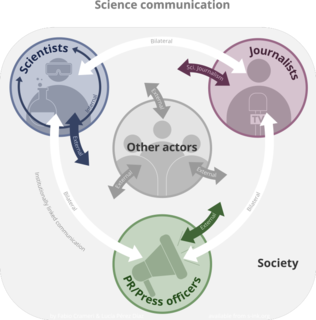
Science communication
Public communication of science-related topics to non-experts / From Wikipedia, the free encyclopedia
Dear Wikiwand AI, let's keep it short by simply answering these key questions:
Can you list the top facts and stats about Science communication?
Summarize this article for a 10 years old
Science communication encompasses a wide range of activities that connect science and society.[1] Common goals of science communication include informing non-experts about scientific findings, raising the public awareness of and interest in science, influencing people's attitudes and behaviors, informing public policy, and engaging with diverse communities to address societal problems.[2] The term "science communication" generally refers to settings in which audiences are not experts on the scientific topic being discussed (outreach), though some authors categorize expert-to-expert communication ("inreach" such as publication in scientific journals) as a type of science communication.[3] Examples of outreach include science journalism[4][5] and health communication.[6] Since science has political, moral, and legal implications,[7] science communication can help bridge gaps between different stakeholders in public policy, industry, and civil society.[8]
| Part of a series on | ||||||
| Science | ||||||
|---|---|---|---|---|---|---|
|
||||||
| This is a subseries on philosophy. In order to explore related topics, please visit navigation. | ||||||

Science communicators are a broad group of people: scientific experts, science journalists, science artists, medical professionals, nature center educators, science advisors for policymakers, and everyone else who communicates with the public about science.[9][10] They often use entertainment and persuasion techniques including humour, storytelling, and metaphors to connect with their audience's values and interests.[11][12][13][14]
Science communication also exists as an interdisciplinary field of social science research[15][2] on topics such as misinformation,[16][17][18] public opinion of emerging technologies,[19][20][21] and the politicization and polarization of science.[22][23][24][25] For decades, science communication research has had only limited influence on science communication practice, and vice-versa,[8][26] but both communities are increasingly attempting to bridge research and practice.[27][28][29]
Historically, academic scientists were discouraged from spending time on public outreach, but that has begun to change. Research funders have raised their expectations for researchers to have broader impacts beyond publication in academic journals.[30] An increasing number of scientists, especially younger scholars, are expressing interest in engaging the public through social media and in-person events, though they still perceive significant institutional barriers to doing so.[31][32]
Science communication is closely related to the fields of informal science education, citizen science, and public engagement with science, and there is not general agreement on whether or how to distinguish them.[33][34][35][36] Like other aspects of society, science communication is influenced by systemic inequalities that impact both inreach[37][38][39][40][41] and outreach.[42][43][44][45][46]